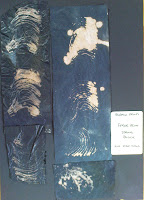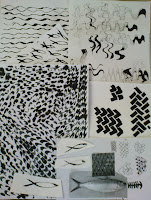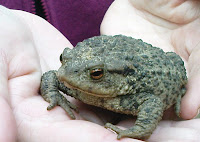Aware of a need to carefully look at how to interpret patterns the idea was to concentrate on a type of pattern/marking in both a drawing, print ideas and stitch. I had become overwhelmed by lots of pictures and sketches and couldn't see the relation with stitched samples so here goes...
The first part of the exercise was to make up story boards using pictures and papers that were being made from the inspiration. A collection of the papers and swatches appears below each of the themed storyboards.
Starting with the ideas of Scales and fish I concentrated on herrings or Silver darlings as they are known in the North east of Scotland.
Ref Page 22 a word image sheet Ref page 23 Range of pen drawings
Could these ideas from my word image sheet be used for printing blocks to sit behind machine stitched columns?
Ref page 22 a) 1 Herring bone stitch perle on 14 hole aida Ref Page 22 a) 2 bone game counter and ink drawing
Working on making printing blocks to progress designs for papers and eventually fabrics the following papers were printed;
Ref page 24 blocks made from word image and drawing sheets
From top left an inkjet print was made of punctuation marks in the shape of fish, an original pen and ink drawing on cartridge paper, a foam stamp made using printing ink pad, original pen and ink drawing on artist paper, foam stamps of herring bone and 'moving' shapes.
From Bottom left original pen and ink drawing on artists paper , print from lino cut using acrylic paint and bottom sample using printing ink - have used pencil to indicate possible stitch line ideas, stamp made from fruit net and printing ink
As well as using the papers for making cuttings for future paper samples my thoughts were considering using digital transfer prints of the samples onto fabric.
The second theme is Feather and birds:
Ref Page 25 word image sheets Ref Page 26 drawing sheets including
monoprints, pencil rubbings and pen drawings
Ref page 27
Top left and centre: monoprint mark making on acrylic painted acetate plate, top right: ink and PVA monoprint
Second row: Left and right monoprint on acrylic painted acrylic plate, centre: third pull of ink/PVA monoprint,
Third row left: acrylic with medium print from foam stamp, centre: second pull of ink monoprint, right, pencil rub of stitched paper
Botton row: panels of pen drawings
The third theme is Skin:
The photo that started the wheels turning!
This little fellow was found on a walk last
April and a colleague decided to take it along for part of the journey. When looking through photos for animal images
I was as much intrigued by the ‘skin prints’ of my friends hand!
Then the second photo came to hand!
While visiting Platt Hall, in Manchester this self
portrait by Audrey Walker caught my eye. On the train journey home I decided
that my skin section should include a study of the skin of the ‘human’ animal’ alongside all my other animals.
 and the resulting inspiration boards for humans and amphibian:
and the resulting inspiration boards for humans and amphibian:
Ref Page 28 Image boards human skin, Ref page 29 paper patterns
Patterns from page 29 top left: footprint cut in strips, top right; print of felt tip drawing of fingerprints in alternate directions,
Second row: mono print acrylic paint and medium on acetate plate first and second pull,
third row; crumpled newspaper rolled with acrylic, magic sponge printed, pencil rub embossed sheet, block print string fingerprint
fourth row: Think these may be disallowed, see below!! acrylic print from embossed papers as with pencil rub above
I felt the human skin patterns could keep me going for a lifetime! But also included early rock drawings, petroglyphs/graphs, which fascinate me. Their history and design simplicity are something to inspire one on a journey where you are trying to find impact and storytelling in a chosen images.
On the amphibian board I chose to put a full blown up picture of the frogs reflection as I felt this could be cut into strips making an interesting composition in the seminole chapter...is this to be allowed?
The paper themes for amphibians
Ref Pages 30
The papers from top left are a magic sponge print using acrylic paint, bubble wrap print with acrylic paint, original pen and ink drawing on cartridge paper, sponge print(second pull off) using acrylic paint, print off of frogging patterns, below which I have made a simple one with silk rats tails - a possible printing stamp! Below this a series of doodles based on frog footprints and stages of life. In the bottom centre a series of round patterns made using various stitches on the machine...see rubbing below.
Ref Page 30 a) detail of pencil rubbing
The last of my inspiration boards shells, horn, beak and claw:
Ref Page 31 word and image board Ref page 32 patterns,
Ref Page 33 Ammonite
I had hoped that the strong shapes would inspire lots of patterns and tried to make the patterns shown on page 32 more dynamic by joining them in a series of radiating patterns but they just appeared cumbersome. While going through my papers I found this simple pattern of an ammonite and decided this could be the piece to work to concentrate on. The results move on into the next chapter...





































